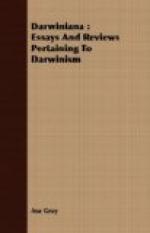The points which Mr. Canby made out are, that this fluid is always poured out around the captured insect in due time, “if the leaf is in good condition and the prey suitable;” that it comes from the leaf itself, and not from the decomposing insect (for, when the trap caught a plum-curculio, the fluid was poured out while he was still alive, though very weak, and endeavoring, ineffectively, to eat his way out); that bits of raw beef, although sometimes rejected after a while, were generally acted upon in the same manner—i.e., closed down upon tightly, salvered with the liquid, dissolved mainly, and absorbed; so that, in fine, the fluid may well be said to be analogous to the gastric juice of animals, dissolving the prey and rendering it fit for absorption by the leaf. Many leaves remain inactive or slowly die away after one meal; others reopen for a second and perhaps even a third capture, and are at least capable of digesting a second meal.
Before Mr. Canby’s experiments had been made, we were aware that a similar series had been made in England by Mr. Darwin, with the same results, and with a small but highly-curious additional one—namely, that the fluid secreted in the trap of Dionaea, like the gastric juice, has an acid reaction. Having begun to mention unpublished results (too long allowed to remain so), it may be well, under the circumstances, to refer to a still more remarkable experiment by the same most sagacious investigator. By a prick with a sharp lancet at a certain point, he has been able to paralyze one-half of the leaf-trap, so that it remained motionless under the stimulus to which the other half responded. Such high and sensitive organization entails corresponding ailments. Mr. Canby tells us that he gave to one of his Dionaea-subjects a fatal dyspepsia by feeding it with cheese; and under Mr. Darwin’s hands another suffers from paraplegia.
Finally, Dr. Burdon-Sanderson’s experiments, detailed at the last meeting of the British Association for the Advancement of Science, show that the same electrical currents are developed upon the closing of the Dionaea-trap as in the contraction of a muscle.
If the Venus’s Fly-trap stood alone, it would be doubly marvelous—first, on account of its carnivorous propensities, and then as constituting a real anomaly in organic Nature, to which nothing leads up. Before acquiescing in such a conclusion, the modern naturalist would scrutinize its relatives. Now, the nearest relatives of our vegetable wonder are the sundews.
While Dionaea is as local in habitation as it is singular in structure and habits, the Droseras or sundews are widely diffused over the world and numerous in species. The two whose captivating habits have attracted attention abound in bogs all around the northern hemisphere. That flies are caught by them is a matter of common observation; but this was thought to be purely accidental. They spread out from the root a circle of small leaves,




